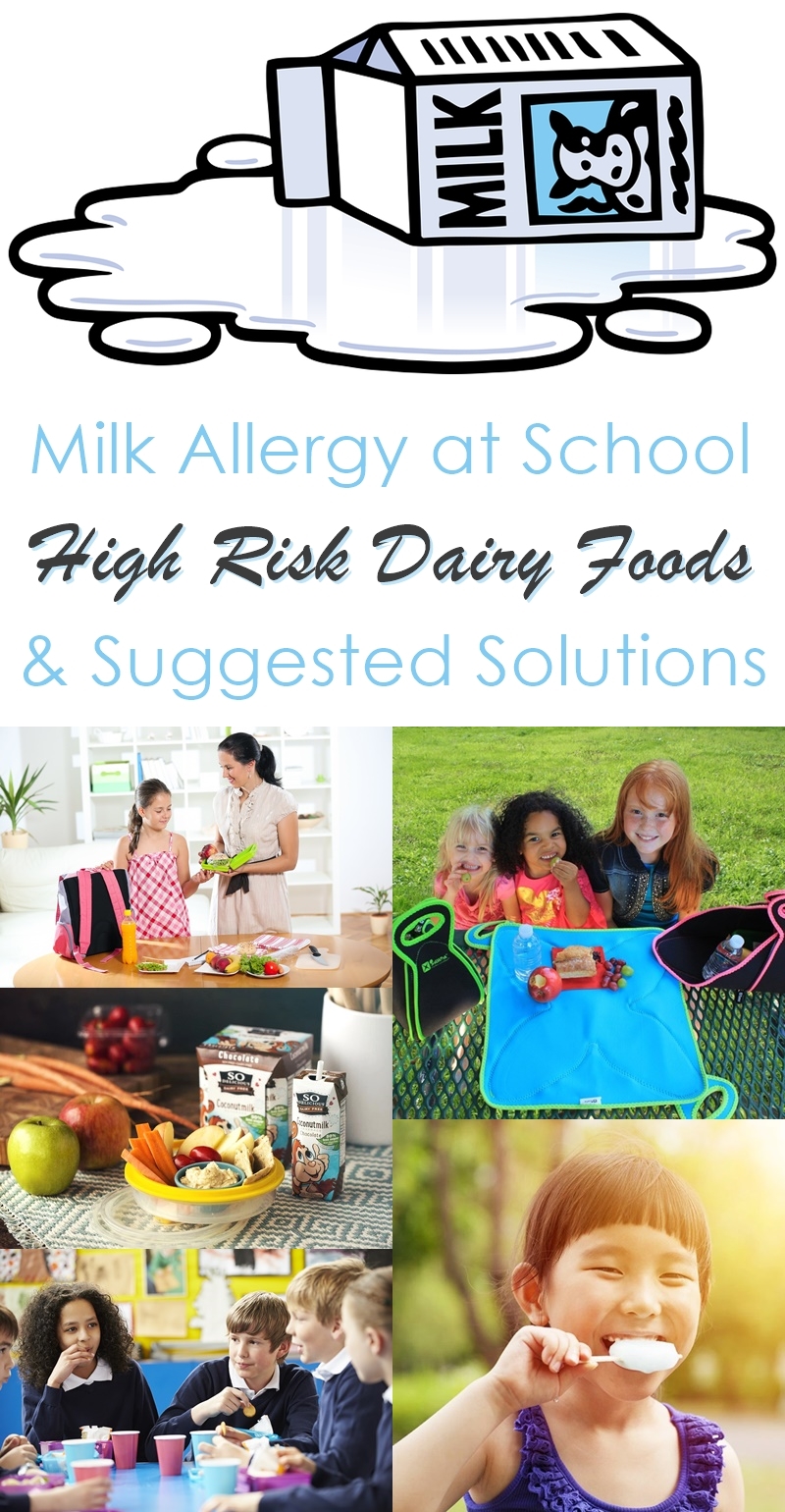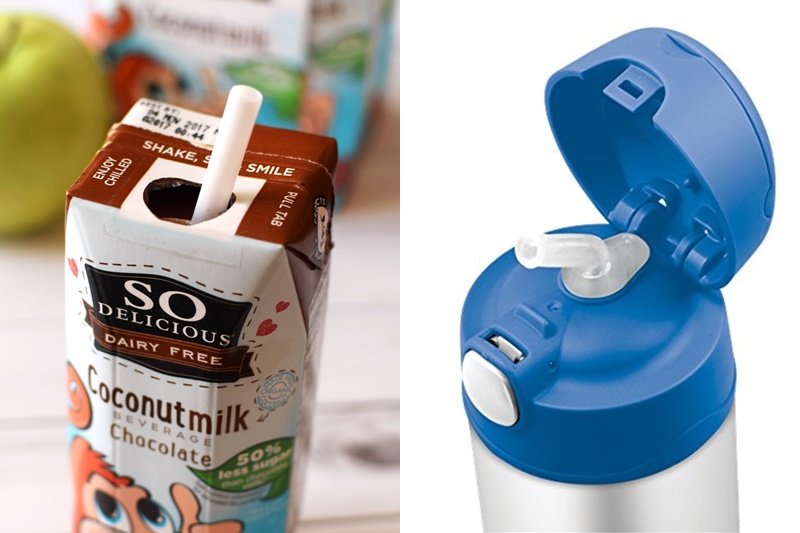There is no doubt that an allergy to any food can be stressful, but milk presents greater issues than most. It’s one of the most revered foods in the American diet, and thanks in part to School Milk Programs, it’s rampant in our schools. For students with milk allergies, high risk dairy foods can seem impossible to avoid. From the “required” milk in government-sponsored lunches to in-class birthday parties with buttery-iced cupcakes and ice cream, dairy is everywhere. Plus, people often confuse milk allergy with a less serious and very common milk reaction, lactose intolerance.
 A while back, I had the opportunity to interview Kelly Rudnicki, a popular cookbook author who has a child with multiple food allergies. His list includes peanuts and tree nuts, but she says his milk allergy is her biggest concern. “The most misunderstanding I get is with milk allergy,” says Rudnicki. “You want every allergen to be taken as seriously as peanut, but if it isn’t a peanut or nut allergy, it’s not getting respect.” Kelly said at least once every school year, something with dairy in it has crossed her son’s path.
A while back, I had the opportunity to interview Kelly Rudnicki, a popular cookbook author who has a child with multiple food allergies. His list includes peanuts and tree nuts, but she says his milk allergy is her biggest concern. “The most misunderstanding I get is with milk allergy,” says Rudnicki. “You want every allergen to be taken as seriously as peanut, but if it isn’t a peanut or nut allergy, it’s not getting respect.” Kelly said at least once every school year, something with dairy in it has crossed her son’s path.
Parents like Kelly are making strides in milk allergy awareness, but the problem won’t resolve overnight. Therefore, I recommend understanding the high risk dairy foods in school and how to manage them.
 This post is sponsored by So Delicious Dairy Free. They asked to be a part of providing helpful milk allergy information for back to school.
This post is sponsored by So Delicious Dairy Free. They asked to be a part of providing helpful milk allergy information for back to school.
High Risk Dairy Foods & Situations
Below are five of high risk dairy foods and situations that occur quite often in most school settings. I’ve included an explanation of the challenges along with some ideas to help you and your milk allergic kid navigate this milk minefield.
Flavored Snacks
When most people think of dairy products, foods like milk, cheese and yogurt immediately come to mind. But in terms of cross-contamination potential, milk powders are tops on the list. They may linger on chips, crackers, popcorn, and other flavor-coated foods and can easily be tracked to different areas (even door handles) with messy hands. And unlike most other dairy foods, milk powders can “float”. Similar to dust particles they might land on desks, tables or other surfaces.
Suggested Solutions:
- Provide the teacher and parents with a “safe snack list” as a guide. Make sure it includes several reasonably priced products. Although many parents won’t reference it, some probably will.
- For those who ignore your list, request that they pack “unflavored” varieties that don’t have a “contains” allergen statement for milk. Most kids will be fine with plain potato chips, tortillas chips or crackers, and don’t need the Ranch or Cheddar to be satisfied.

Spilled Milk
Yes, it happens with great regularity in schools from pre-K on up through high school. The milk cartons that school lunch programs provide have nice wide spouts that can cause a cannonball-style splash when dropped or toppled.
Suggested Solutions:
- Fluid milk can spread fast and far, but it’s more visible than milk powders making it much easier clean. Make sure the teacher, cafeteria staff and friends of your kid understand a protocol for quickly and thoroughly cleaning any spills.
- For kids who bring their own milk, request that parents buy enclosed single-serves, or that they pack it in a thermos with a sip-top rather than a lid opening.

Smeared Soft Foods
Soft cheeses, yogurts, puddings, and squeeze tubes are common in lunch boxes and can easily spread on hands and eating areas.
Suggested Solutions:
- You can provide a list of safe brands on your snack list. Dairy-free yogurts are becoming readily-available, and a few parents may be excited about the options.
- Ensure that the classroom has desk-wiping and hand-washing policies after food is eaten in a classroom. This is becoming a typical procedure and helps to prevent sticky hands from transferring food to common surfaces.
- Provide your kid with a place-covering, to shield their eating area from any residues that may remain on the table. There are even some very cool lunch boxes that fold out.
- Pack along some wet wipes for them to clean their eating area as needed.

Lunch Box Swaps
Kids frequently trade lunchbox goods or may simply offer to share. The answer may seem straight-forward: tell your child or teen not to take food offerings from others. But around their peers, they may feel awkward, left out, or simply too tempted to resist. And if your child has never experienced anaphylaxis or another severe reaction before, they may not fully associate the consequences.
Suggested Solutions:
- Talk to your kid’s closest friends and their parents. Make sure they understand the severity of the milk allergy, and encourage them not to suggest food sharing when your kid is present.
- Pack lunches that they love! Satisfying treats like dairy-free chocolate “monkey” milk singles, allergy-friendly cookies, or a bag of their favorite chips can help to keep curiosity at bay. Also, keep their lunch interesting with favorite sandwiches, “sushi” rolls, tacos and other family favorites.
- Keep an eye on their lunch box to see if any foods are returning home. And check in with them every month or so to find out if there are any lunch box items they don’t particularly like. They may also want to mention foods they’ve seen other kids eating that they want to try, too. All these things can help you make lunches that prevent the desire for trades. As they get older, involve them in the lunch making and the grocery shopping processes.

School Events
For some reason, food has become a primary reward in schools, with pizza parties and ice cream socials topping teachers’ go-to lists. And while your kid could simply abstain, this can easily make them feel left out.
Suggested Solutions:
- Present teachers and other school officials with food-free fun options. Kids often appreciate these even more!
- Request to store dairy-free, individually-wrapped ice cream bars at the school. They typically have a freezer available for the faculty or in the nurse’s office, and with a doctor’s note, they might be able to accommodate.
- Keep your own stock of frozen dairy-free cupcakes. When a birthday or treat day is on tap, pop one of the frozen cupcakes into your child’s lunch box. It should defrost in time for the celebration.
- Try to time your child’s lunches with what may be served at school. If a pizza day is happening, pack some homemade dairy-free pizza or a pizza sauce “dip” with breadsticks.

To further safeguard your allergic child or teen, it’s important to understand your rights. 504 Plans, an Individual Health Care Plan, and other accommodations are available for food allergic kids in school. These can help to implement some of the suggested solutions above and protect a loved one with milk allergy from high risk dairy foods.
For more dairy-free solutions and recipes, enjoy my latest book, the 2nd Edition of Go Dairy Free: The Guide and Cookbook (massively expanded!).


46 Comments
This is such a great article! Since none of my kids have serious food allergies, this was a real eye-opener for me.
So appreciative that you took the time to read it and understand Wendy! It means the world to those who do have concerns.
I shared this on my FB page – So helpful for those with dairy allergies or wanting to learn more!
Thank you Keeley!
This post makes me so incredibly grateful that my boys do not have any food allergies. Thank you for the very informative post!
I totally agree that the emphasis in schools is on nut allergies. My daughter is only in her 2nd week of preschool and I’ve already lost track of how many emails and handouts I’ve received about classmates with nut allergies and school policies. I don’t recall reading anything about milk allergies…Thanks for all of the great information and helpful solutions!
I know, it’s hard to believe that the prevalence of milk allergies is right up there close to nuts!
My son has tons of food allergies, but dairy is the one I worry about the most–way more than even peanut. It’s so ubiquitous to the American diet. Great article–will be sharing on all my platforms.
Thank you Megan – for sharing your own stress with it and for sharing with others 🙂
These are great suggestions! People don’t realize how easy it to make simple substitutions that make life easier for everyone!
Thank you for sharing these tips and reminding us how every allergy is important
It does amaze me how little people understand what types of foods are…I remember telling my family I needed to cut out dairy and then consistently getting offers for ice cream or cream cheese…because apparently only milk is dairy 😉
Honestly, my husband and I have been together for 20 years, and my in-laws still do stuff like that and like to attempt making it more of an embarrassment than anything else. It really bothers them for some reason, but luckily it doesn’t bother me! It really frustrated them when their son went dairy-free AND gluten-free 🙂
Such a helpful and informative post! Loved your suggestions for various life situations!
This is a fabulous resource for moms with kids who can’t have dairy. Thanks for making this available.
These are such great tips! Educating about the issue is so important. Great post!
“You want every allergen to be taken as seriously as peanut, but if it isn’t a peanut or nut allergy, it’s not getting respect.” AMEN!
It would be so hard to have a severe allergy! I think it’s important to teach our kids with allergies that they need to be on the lookout (hard for young ones I know). You’d hope that every adult in their lives would be watching out for the child, but it really has to become their responsibility. I love these ideas for parents to help their kids not feel left out!
One great tip I learned from a parent is that she had her kid have their own placement and everything on that placemat was the allergy free zone, it helped kids indenify it and remind teachers to only put approved foods on it.
Yes, I love that tip! I really like the Solvetta lunchbags above as they are a built in placemat! They zip open.
This is a great post! I love lunch box trading as a kid, but now it is scary to think about children with allergies, very eye opening!
Such smart and useful info as so many kids now have dairy allergies.
These are great tips! Managing a milk allergy at school can be very difficult because dairy has been heralded as a staple in the American diet, it’s in so many foods, and it’s messy to boot!
Seriously messy! Even us adults struggle with people when trying to manage it, but kids haven’t always found their voice.
It’s true that most allergies do not get the same respect that tree nut and peanut allergies get. While we do not have any food allergies, I’m glad our schools enforce a no-food policy for birthdays. Kids are allowed to bring in pencils, stickers, erasers, etc, or my personal favorite – donate a book in the child’s name to the school library. It’s a step in the right direction.
That’s fabulous Jenn and a HUGE step in the right direction.
Yes, it’s true all food allergies that aren’t nut related are so much more difficult to get people to understand the severity of. Any food allergy someone has can be life threatening and they all need to be taken seriously and respected.
I’m an adult with lactose intolerance, and it sucks being left out. I can’t imagine being a kid and not being able to partake in a pizza party, or worse having to leave the room if milk is spilt! 🙁
It’s sad that our society seems to take peanut and gluten dietary restrictions seriously, but not milk.
I agree Keith! And as frustrated as people get when milk allergies and lactose intolerance are confused, I think lactose intolerance doesn’t get the respect it deserves either. Symptoms can be severe and affect quality of life.
Thank you! My lactose intolerance is pretty severe, and it’s really annoying when people tell me, who cares, just eat the pizza! No, I don’t want to spend the rest of the evening doubled over in pain in the bathroom while everyone else is having a good time! The anxiety of not knowing when or where the symptoms will hit aren’t worth it!
Certainly the stakes are much lower compared to a full blown dairy allergy, but that doesn’t mean I’m going to voluntary make myself feel like garbage…
Okay, rant over 🙂
Amen Keith!